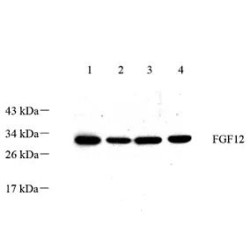Protein tags are protein or peptide sequences located either on the C- or N- terminal of the target protein, which facilitates one or several of the following characteristics: solubility, detection, purification, localization and expression. His-tag is often used for affinity purification and bindin..
£250.00
This gene encodes an important intermediate enzyme in polyamine biosynthesis. The polyamines spermine, spermidine, and putrescine are low-molecular-weight aliphatic amines essential for cellular proliferation and tumour promotion. Two alternatively spliced transcript variants that encode differ..
£270.00
Most of autosomal dominant familial AD can be attributed to mutations in one of three genes: those encoding amyloid precursor protein (APP) and presenilins 1 and 2 Most mutations in the APP and presenilin genes increase the production of a small protein called Aβ42, which is the main component of se..
£250.00
This gene encodes a cell surface receptor and transmembrane precursor protein that is cleaved by secretases to form a number of peptides. Some of these peptides are secreted and can bind to the acetyltransferase complex APBB1/TIP60 to promote transcriptional activation, while others form the protein..
£210.00
CD44 is the receptor for hyaluronic acid (HA). It mediates cell to cell and cell matrix interactions through its affinity for HA. Adhesion with HA plays an important role in cell migration, tumour growth and progression. Also involved in lymphocyte activation, recirculation and homing, and in haemat..
£220.00
The CD8B antigen is a cell surface glycoprotein found on most cytotoxic T lymphocytes that mediates efficient cell-cell interactions within the immune system. The CD8 antigen, acting as a coreceptor, and the T-cell receptor on the T lymphocyte recognize antigens displayed by an antigen presenting ce..
£220.00
Regulates vascular tubulogenesis in vivo. Inhibits platelet-derived growth factor (PDGF)-BB-induced smooth muscle cell migration and promotes endothelial cell adhesion to the extracellular matrix and angiogenesis...
£220.00
Enhanced green fluorescence protein (eGFP) is a 27 kDa protein derived from the jellyfish Aequorea Victoria, which emits green light (emission peak at a wavelength of 509 nm) when excited by blue light (excitation peak at a wavelength of 395 nm). eGFP has become an invaluable tool in cell ..
£290.00
The protein encoded by this gene is a transmembrane glycoprotein that is a member of the protein kinase superfamily. This protein is a receptor for members of the epidermal growth factor family. EGFR is a cell surface protein that binds to epidermal growth factor. Binding of the protein to a ligand ..
£290.00
The protein encoded by this gene is a transmembrane glycoprotein that is a member of the protein kinase superfamily. This protein is a receptor for members of the epidermal growth factor family. EGFR is a cell surface protein that binds to epidermal growth factor. Binding of the protein to a ligand ..
£215.00
The protein encoded by this gene is a member of the fibroblast growth factor (FGF) family. FGF family members possess broad mitogenic and cell survival activities, and are involved in a variety of biological processes, including embryonic development, cell growth, morphogenesis, tissue repair, tumou..
£250.00
FGF12 is a member of the fibroblast growth factor (FGF) family. FGF family members play important roles in embryogenesis, angiogenesis, and wound repair. FGF12 lacks the N-terminal signal sequence present in most of the FGF family members, but it contains clusters of basic residues that have been de..
£250.00













